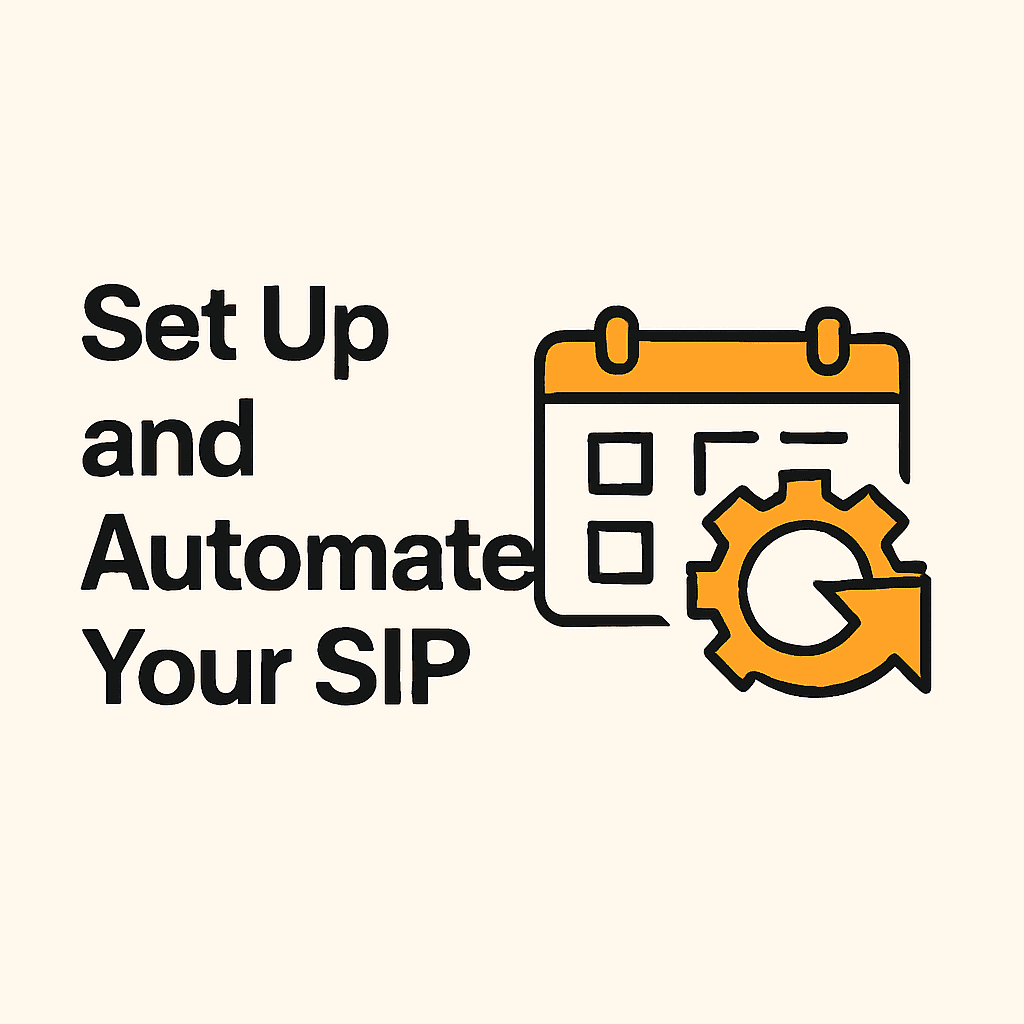Introduction
Imagine this: It’s a fresh morning in 2025. You’re sipping your chai, scrolling through your phone, and a question lingers — “Where is all my salary going?” You save a little, spend a lot, and at the end of the month, there’s barely anything left that feels like real growth.
If this feels familiar, you’re not alone. Thousands of first-time earners are in the same boat – looking to grow their savings but unsure where to begin. The good news? You don’t need a finance degree or a huge bank balance to start. All you need is a method. That’s where Starting SIP comes in.
SIP, short for Systematic Investment Plan, is one of the smartest and simplest ways for beginners to start investing in mutual funds. It’s designed for people exactly like you — someone who wants to do more with their money, without overcomplicating things. This article is your friendly guide to understanding SIP investment for beginners, especially in the context of 2025’s evolving economy and digital tools.
What Exactly Is an SIP?
Think of an SIP as a financial habit — like setting aside a little money each month, but instead of just saving it, you’re putting it to work in the market through mutual funds. Over time, this consistent investing has the potential to grow into something much bigger.
What makes a systematic investment plan for beginners so appealing is its simplicity. You don’t need to time the market or understand complex stock charts. All it takes is consistency, and the market does the rest.
Why Beginners Love SIPs
- You can start small, as little as ₹500/month.
- No need to time the market, SIPs benefit from cost averaging.
- It grows with you, increase your amount as your income rises.
- Flexible, pause, stop, or adjust as per your needs.
In short, SIPs aren’t just about money. They’re about building discipline — the kind that pays off big in the long run.
Why 2025 Is a Great Year to Begin SIPs
The landscape of personal finance has evolved, and 2025 offers a unique blend of opportunity and accessibility:
- Inflation is expected to hover around 4–6%, which means your savings need to earn more just to stay ahead.
- Banks aren’t offering much — typical savings interest is still around 3%. SIPs, especially in equity mutual funds, have historically delivered around 10–12% annually.
- Digital investment platforms like Groww, Paytm Money, and Zerodha Coin have removed the technical barriers that once kept beginners out of the game.
- Most importantly, the best SIP plans for beginners are tailored to small investors — no massive amounts or complex paperwork.
If you’re considering starting SIP, this is the year to do it.
The Beginner’s Roadmap to Starting SIP in 2025
Step 1: Clarify Your Financial Intentions

Before putting your money anywhere, think about your goals. Are you saving for a new phone? A down payment? Retirement?
This clarity will guide your choices. Here’s a simple way to match goals with fund types:
- Short-term (1–3 years): Safer debt funds
- Mid-term (3–5 years): Balanced or hybrid funds
- Long-term (5+ years): Equity mutual funds for better growth
This is your starting line. Once you know where you want to go, choosing the vehicle becomes easier.
Step 2: Understand Your Risk Personality

Not everyone is comfortable with market ups and downs — and that’s okay.
Ask yourself:
- Am I okay if the market dips for a few months?
- How soon do I need this money?
- What other financial responsibilities do I have?
Based on your answers:
- Conservative? Look at debt or hybrid mutual funds.
- Balanced? Multi-cap or large-cap equity funds might work.
- Aggressive? Explore small-cap equity mutual funds.
This step ensures that your chosen fund won’t cause sleepless nights.
Step 3: Get Your KYC Done

Don’t let the acronym scare you. KYC (Know Your Customer) is just your basic ID verification, required by SEBI.
What you’ll need:
- PAN card
- Aadhaar
- Address proof (like an electricity bill)
- A recent passport-size photo
Most platforms now offer online KYC with OTP-based Aadhaar verification. The process takes less than 10 minutes.
Step 4: Choose the Right Fund

Don’t fall for flashy names or 1-year return charts. The best mutual fund SIP for beginners is one that matches your goal and risk level.
Some fund types:
- Equity Funds: Great for long-term growth.
- Debt Funds: More stable, suited for short-term plans.
- Hybrid Funds: A mix of both — for balanced investors.
- ELSS Funds: Equity-linked saving schemes that offer tax benefits.
Focus on:
- 3 to 5-year performance, not just recent returns
- Low expense ratios
- Consistent fund managers
- Reputed AMC (HDFC, ICICI, SBI, etc.)
Remember: You’re not looking for the “hottest” fund. You’re looking for a reliable travel companion for your financial journey.
Step 5: Pick Your Platform

Thanks to 2025’s digital revolution, investing has never been easier.
Popular beginner-friendly platforms:
- Groww — Great UI and easy SIP setup
- Zerodha Coin — Excellent for direct plans with lower fees
- Paytm Money — Clean experience and reliable support
Make sure your platform offers:
- Direct mutual fund access
- SIP calculator tools
- Portfolio tracking
- Strong customer support
Step 6: Set Up and Automate Your SIP

You’re almost there! Now:
- Select your fund
- Decide the amount and frequency (monthly is best)
- Set up auto-debit from your bank or UPI
- Click “Start SIP”
That’s it. You’ve officially begun your investment journey.
Step 7: Review, Don’t Obsess

You don’t need to check your SIP every day. In fact, you shouldn’t.
Just make it a habit to review every 6–12 months:
- Are you on track with your goals?
- Has your income increased? Top-up your SIP.
- Is your fund underperforming for a long stretch? Consider switching.
Think of it like checking the air in your car tires — regular but not obsessive.
Avoid These Common Mistakes
New investors often fall into these traps:
- Chasing high past returns: What worked last year may not work this year.
- Pausing SIPs during market crashes: That’s when you’re buying low — the best time to stay invested.
- Ignoring expense ratios: Higher fees = lower profits.
- Putting all money into one fund: Diversify.
- Mismatch between goal and fund type: Don’t use equity funds for short-term goals.
Avoiding these simple errors will set you far ahead of the average investor.
Pro Tips for Serious Wealth Building
Once you’re comfortable, here’s how to take it to the next level:
- Start early, even if small: Time beats amount when compounding works.
- Use Top-Up SIPs: Increase your SIP amount by 10–15% every year.
- Explore ELSS Funds: Save tax under Section 80C while investing.
- Leverage automation tools: ET Money, Kuvera, Zerodha — use them to rebalance and track.
These are the tweaks that turn good investments into great ones.
Frequently Asked Questions
Which SIP plan is best for beginners?
✅ Axis Bluechip Fund – Stable returns, low risk
✅ Parag Parikh Flexi Cap Fund – Diversified & beginner-friendly
✅ ICICI Prudential Balanced Advantage Fund – Equity + Debt balance
💡 Start with ₹500–₹1000/month
💡 Choose Direct Plan – Growth Option
💡 Stay invested for at least 3–5 years
What is the 7 5 3 1 rule in SIP?
📅 7 Years: For equity investments to potentially double your money
🖐️ 5 Years: Ideal holding period for hybrid/balanced funds
🔁 3 Years: Recommended for debt mutual funds
☝️ 1 Year: Minimum for liquid funds or short-term goals
💡 This rule helps beginners match SIP duration with fund type and financial goals.
Can I start SIP by myself?
✅ Yes, you can start SIP online without any agent
🪪 Just complete KYC with PAN, Aadhaar & bank details
📱 Use trusted apps like Groww, Zerodha Coin, Kuvera, or Paytm Money
🧾 Select a mutual fund, amount, and SIP date
⏳ Takes less than 10 minutes to begin
💡 No paperwork needed — fully digital process!
Is SIP 100% safe?
⚠️ No, SIP is not 100% risk-free — returns depend on market performance
📉 SIP reduces risk through rupee cost averaging
📈 Long-term SIPs in equity funds can handle market ups & downs
✅ Debt & hybrid funds carry lower risk, but not zero
🔒 SIP is disciplined & safer than lump sum investing, but not guaranteed
💡 Invest as per your risk profile and time horizon
Can I withdraw SIP anytime?
✅ Yes, SIP investments can be withdrawn anytime
⏳ But exit load may apply if withdrawn early (usually within 1 year)
🔒 ELSS funds have a 3-year lock-in period
💼 Partial or full withdrawal is possible from most mutual funds
📱 Withdraw online via app or mutual fund platform in minutes
💡 Check the fund’s exit load and tax rules before withdrawing
Final Thoughts
There’s no perfect time to start investing. There’s only your time — and it starts now. Whether you’re earning ₹25,000 or ₹2.5 lakhs per month, starting SIP is your step towards taking control of your future.
The beauty of SIPs is in their simplicity. You don’t need to be an expert. You just need to be consistent. And in 2025, with all the tools and knowledge at your fingertips, you have everything you need to succeed.
So go ahead — define your goals, pick your plan, and start investing. You’ll thank yourself a few years down the line.
Resources & Tools
- SIP Calculator – Groww, AMFI
- Budgeting: Moneycontrol App
- Books: The Intelligent Investor, Rich Dad Poor Dad
Disclaimer: Mutual fund investments are subject to market risks. Please read the scheme documents carefully before investing. Consult a SEBI-registered advisor if you need help.

Piyush is the founder of EarnEdgeNow.com. He writes about online earning, investments, and job updates to help Indian youth grow smarter with money.


